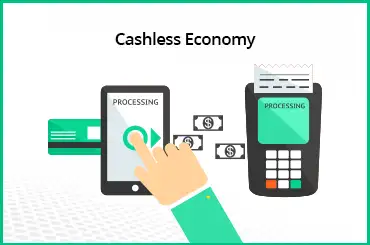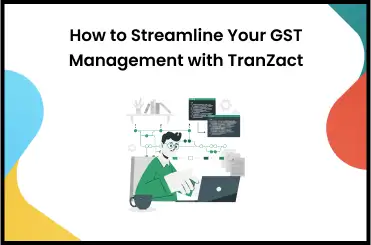You must know the various types of GST returns in India as a business owner. Ever since the launch of the goods and service tax in 2017, it has become imperative for organizations to register under the GST Act.
Any individual or business entity willing to do business in India should comply with the regulations, and GST registration is one of them. In this comprehensive guide, we have discussed the different types of GST returns in India and the key aspects associated with them.
GSTR-1 - Details of Outward Supplies
GSTR-1 is the quarterly filing of the GST by normal as well as casual registered taxpayers. It encompasses all the details of outward supplies or sales. The turnover of the taxpayer determines the due date for the GSTR 1 filing. It is on the basis of GSTR-1 that recipients of supplies claim their input tax credit when filing a GST return. Therefore, it is important to declare GSTR-1 properly without delay. Failing to pay GST on time or missing out on the GSTR-1 registration can negatively impact business compliance and reputation.
Who needs to file GSTR-1?
Every taxable person who has registered for GST needs to file GSTR-1. This excludes input service distributors or composition taxpayers and persons liable to deduct tax u/s 51 / persons liable to collect tax u/s 52 are required to file Form GSTR-1.
What details are required to be filed in GSTR-1?
The details that need to be provided in GSTR-1 for outward supplies include the taxpayer's GSTIN, invoice details, details of supplies made to registered and unregistered persons, HSN codes for goods, and tax liability.
Frequency of Filing GSTR-1
A company with an annual turnover of up to Rs. 1.5 crore can do the filing quarterly. However, companies with more than Rs. 1.5 crore of the turnover needs to file GSTR-1 monthly.
Late Filing and Penalties
As we have mentioned above, defaulting on GST payments can invite penalties. After the due date, a late fee of Rs. 50 per day (Rs. 20 for taxpayers with nil liabilities) will be charged for each day of delay. This amount can go up to Rs. 5,000. In addition, interest at the rate of 18% per annum will be charged on the tax liability.
Tips for Filing GSTR-1
- Keep your IDs and transaction details handy.
- Log in and go to the GSTR-1 on the GST portal
- Make sure all the required outward supplies details are provided.
- Even if there are no sales, file the return as NIL.
- If you are unsure about filing a GSTR-1 return, take expert assistance.
GSTR-3B - Monthly Summary Return
GSTR-3B is a self-declared monthly filing of GST that has the summary of all the inward and outward supplies of the taxpayer. The purpose of the GSTR-3B return is that taxpayers must declare their entire GST liabilities in a specific tax period and clear these liabilities.
Who needs to file GSTR-3B?
Re-taxpayer who is registered under the GSTR-3B must file his declaration. The following are eligible for the GSTR-3B registration:
- A taxpayer under the composition scheme
- NRI suppliers of OID air service
- NRI taxable individuals
- Input service distributor
What details are required to be filed in GSTR-3B?
The details that need to be included in this are:
- GSTIN of the taxpayer
- Total inward and outward supplies
- Tax liability
In this GST form, taxpayers do not need to give any invoice details when they are filing GSTR-3B returns.
Frequency of Filing GSTR-3B
The timeline for filing the registration of GSTR-3B is the 20th of every succeeding month.
Late Filing and Penalties
As per the CGST Act, defaulters will be charged Rs. 50 per day if you are taxable. A penalty is Rs. 20 per day of delay for those taxpayers who have NIL tax liability.
Tips for Filing GSTR-3B
- Filing GST is simple. For this, you need to log on to the official GST portal. From there, you can select 'Services'> 'Returns'> 'Returns Dashboard'. Here you can see the File Registration Tab. Select it and then start the reregistration process.
- Make the right entry to ensure that all the rises are accurate.
- Do not copy-paste the values.
- Do cross-check all the details carefully.
GSTR-2A - Details of Inward Supplies
GSTR 2A is generated automatically from the taxpayer's seller's GSTR-1 on the GST portal. It is related to purchases i.e. inward supplies. You don't need to file form GSTR-2A. It is a read-only document that is given to taxpayers as a record of all the invoices they have received from suppliers during a certain tax period. This is used as a reference when filing GSTR-3B and GSTR-9.
Who needs to view GSTR-2A?
The taxpayer must download the GSTR-2A if the number of invoices is more than 500 in number.
What details are included in GSTR-2A?
It includes the details of all the purchases made by the taxpayer during the defined period. It includes the GSTIN, invoice value, and amount of tax paid.
Importance of Reconciling GSTR-2A With Purchase Records
The GSTR-2A reconciliation aims at helping businesses match the invoices and identify if there is any mismatch or difference. Timely GSTR-2A reconciliation helps you find the missing invoices in GSTR-2A.
GSTR-4 - Quarterly Return for Composition Dealers
GSTR-4 is an annual return form to be filled in by the composition dealer. GSTR-4 consists of a consolidated summary of a composition dealer's outward supplies, tax liability, and payment of tax for the quarter. The GSTR-4 form is used to see the details related to Tax Deducted at Source (TDS) or Tax Collected at Source (TCS) credit received in the year.
Who needs to file GSTR-4?
Taxpayers who have registered under the composition scheme of GST need to file GST4 i.e., composition dealer.
What details are required to be filed in GSTR-4?
The GSTR-4 contains details of supplies received by registered vendors. They can be interstate as well as intrastate.
Frequency of Filing GSTR-4
A normal taxpayer needs to file the same every three months.
Late Filing and Penalties
Failing to file the GST can invite penalties. The defaulter needs to pay a late fee of Rs. 50 per day up to a maximum of Rs.2,000. In the care where tax liability is nil, the maximum late fee is Rs. 500.
Tips for Filing GSTR-4
The registered taxpayer under the composition scheme must file GSTR-4 and must have registered and opted for the scheme during the relevant financial year.
- Keep a record of the aggregate turnover of the preceding fiscal year.
- Timely payment is a must to avoid penalties
- One can easily file the GSTR 4 by logging on to the online portal.
GSTR-5 - Return for Non-resident Foreign Taxpayers
This GST tax return needs to be filed by a non-resident taxable person who has completed GST registration. This return is for only that period when they run a business or do business transactions in India. They can file this online or by visiting the tax facilitation center.
Who needs to file GSTR-5?
Non-Resident Indians (NRIs) who are taxable and have registered under GST need to file GSTR-5.
What details are required to be filed in GSTR-5?
One needs to mention the details of the taxpayer, inward supplies received from the vendors, amendments of inward supplies, and outward supplies.
Frequency of Filing GSTR-5
The due date for filing GSTR-5 is the 30th of the successive month. For example, if one needs to file a return for October 2023, then the due date would be November 2023.
Late Filing and Penalties
If there is a delay in filing the penalties, the individual will be liable to pay Interest and a late fee. This is usually 18% per annum. This is calculated by the outstanding amount that a taxpayer needs to pay. The period of the same would be the next date of filing to the date of payment. A late fee of Rs. 50 up to a maximum of Rs. 5000 is levied.
Tips for Filing GSTR-5
There are a total of 14 headings that one needs to fill, it includes GSTIN, Name of the taxpayer, the validity period of registration, inputs or capital goods received from overseas (or by the import of goods), taxable outward supplies made to registered persons (including UIN holders), along with taxable outward inter-state supplies to un-registered persons where invoice value is more than Rs 2.5 lakhs, and amendment in the details furnished in any earlier return.
Further, it includes taxable supplies (net of debit notes and credit notes) to unregistered persons other than the supplies, amendments to taxable outward supply details furnished in returns for earlier tax periods, amendments to taxable outward supplies to unregistered persons furnished in returns for earlier tax periods, total tax liability, tax payable and paid, interest, late fee and any other amount payable and paid, refund claimed from electronic cash ledger, debit entries in electronic cash or credit ledger for tax and interest payment.
- Make sure that all the details are accurate.
- Reconcile input tax credit with purchase registers.
- Review all details carefully before filing.
GSTR-6 - Return for Input Service Distributors
Every Input Service Distributor needs to present the details of the invoices in the GSTR 6 form and file a monthly return mentioning all the details of the invoice on which they have received the credit.
Who needs to file GSTR-6?
In addition to every Input Service Distributor, the following need to file the GSTR-6:
- Composition Dealers
- Compounding taxable person
- Non-resident Taxable Person
- Suppliers of OIDAR (Online Information and Database Access or Retrieval)
- Taxpayers liable to collect TCS
- Taxpayers liable to deduct TDS
What details are required to be filed in GSTR-6?
- GSTIN of the Input Service Distributor (ISD)
- Details of ISD
- Details of invoices
- Details of credit received
- Details of credit distributed
- Amendments to details of invoices
- Amendments to details of credit distributed
- Tax payable and paid
- Reversal of input tax credit
Frequency of Filing GSTR-6:
The GSTR 6 must be filed on the 13th of the succeeding month. For example, if an induvial needs to file a return for January 2023, then it will be filed in a consecutive month, i.e. 13th February 2023.
Late Filing and Penalties
The last date for filing GSTR 6 is the 13th of the succeeding month.
Tips for Filing GSTR-6
- GSTIN: First, all the details mentioned in the GST filing should be accurate.
- Mention the GSTIN number. It is a 15-digit number that includes a 2-digit state code, a 10-digit permanent account number, and a 3-digit includes state, future use, and check-digit.
- Mention the name of the taxpayer.
GSTR-7 - Return for Tax Deducted at Source
This needs to be filed by those who deduct tax at the time of making or crediting a payment to suppliers towards the inward supplies received. The person for whom TDS has been deducted can claim TDS as Input Tax Credit (ITC) and use it for paying his output tax liability.
Who needs to file GSTR-7?
Any taxpayer who is required to deduct TDS under GST needs to file GSTR-7. This includes government agencies, public sector undertakings, and other specified entities.
What details are required to be filed in GSTR-7?
The details to be filled in GSTR -7 are details of the TDS that has been deducted, TDS liability payable and paid, and TDS refund claimed.
Frequency of Filing GSTR-7
The GST must be filed by the 10th of every month. For example, if a taxpayer needs to file GSTR-7 of Feb 2023, then it must be filed by 10th March 2023.
Late Filing and Penalties
Failure to file the GST on time may invite penalties. In this case, the defaulter needs to pay a penalty of Rs.100 under CGST and Rs.100 under SGST. So, a total of Rs.200 per day. The maximum amount shall not increase up to Rs. 5000. In addition, one has to pay an interest of 18% per annum. It is applied to the TDS paid.
Tips for Filing GSTR-7
- Make sure that you fill in all the details carefully.
- Log on to the official website of the company, and add the required information like the name, period for which you need to file the GST, and other information.
GSTR-8 - Return for Tax Collected at Source
This is the return filed to collect tax from e-commerce companies. It must be filed every month on or before the 10th by e-commerce companies.
Who needs to file GSTR-8?
Any individual or a company that is operating, running, or managing an e-commerce platform needs to file GSTR 8. The e-commerce operators need to collect the TCS from their suppliers. The E-commerce Operator collects tax @1% (i.e. 0.5% CGST and 0.5% SGST and 1% For IGST) of the net value of taxable sales made through the online platform by other suppliers.
What details are required to be filed in GSTR-8?
The below details need to be filled in GSTR 8:
- The GSTIN
- The legal name of the taxpayer
- Details of supplies made through e-commerce operator
- Amendments to supplies
- Details of interest
- Tax payable and paid
- Interest payable and paid
- Refund claimed from electronic cash ledger
Frequency of Filing GSTR-8
The GSTR-8 filing frequency can be:
Monthly Returns: The TCS collector is required to file the TCS return within 10 days after the month's end. Annual Returns: The e-commerce operators need to file an annual return using the GSTR-9B form. This is done on 31st December following the end of every financial year.
Credit Claim: After filing the GSTR-6, the e-commerce operators need to claim credit which is visible in the Supplier's Electronic Cash Ledger.
Late Filing and Penalties
Defaulting in the filing of GSTR 8 invites a penalty. One is obligated to pay a penalty of Rs. 200 (Rs. 100 CGST and Rs. 100 SGST/UTGST) per day. This amount can be a maximum penalty of Rs. 5,000.
Tips for Filing GSTR-8
- You can file GSTR-8 online by logging on to https://www.gst.gov.in/.
- Make sure that you fill in all the details aptly.
- Keep a record of all the transactions to ensure to keep a proper record of the transactions for easy reconciliation and filing of GSTR-8.
FAQs on Types of GST Returns
1. What are the different types of GST returns?
There are different types of GST returns in India; these include GSTR-1, GSTR-2A, GSTR-3B, GSTR-4, GSTR-5, GSTR-5A, GSTR-6, GSTR-7, GSTR-8, GSTR-9, GSTR-9A, GSTR-9C, and GSTR-10.
2. Is there any penalty for late payment or submission?
Yes, failing to comply with the payment timelines for GST return forms may invite penalties.
3. What is GSTR-9C?
It is a reconciliation statement that businesses need to file along with their GSTR-9 return. This statement provides a reconciliation of the taxpayer's declared turnover with the audited financial statements.
















